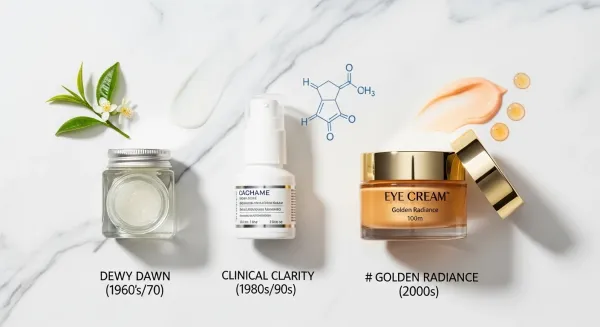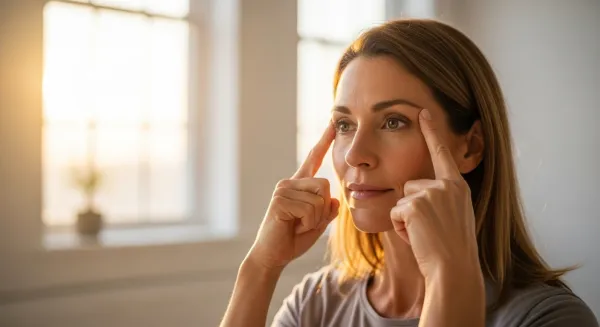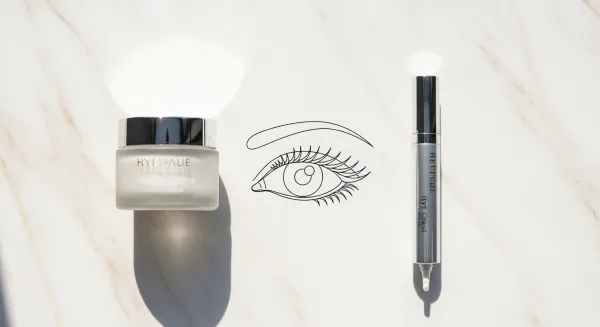Best Eye Creams for Puffiness: What Actually Works
Tired of puffy eyes? We reveal what actually works. Discover dermatologist-backed eye creams, key ingredients, and application tips to finally see results.

Best Eye Creams for Puffiness: What Actually Works
Finding the best eye creams for puffiness can feel like searching for a needle in a haystack when half the products don't deliver on their promises. I've spent years testing products and talking to experts, and today I'm breaking down exactly what works and what doesn't.
Here's the truth: not all puffiness is created equal. And the reason most people waste money on eye creams is because they're treating the wrong type of puffiness with the wrong solution.
Why Your Eyes Are Puffy (And Why It Matters)
Before you spend another dollar on products, you need to understand what's actually happening under your eyes. There are two main types of puffiness, and they require completely different approaches.

Type 1: Fluid Retention (The Morning Swelling)
This is the kind where you wake up looking like you went three rounds in a boxing match. Your eyes are puffy, swollen, and gradually improve throughout the day. This happens because:
- Fluid accumulates when you're lying flat
- Salt from last night's dinner is holding onto water
- Your lymphatic system hasn't kicked into gear yet
- Allergies or sinus issues are causing inflammation
The good news? This type responds incredibly well to the right eye creams combined with proper application techniques.
Type 2: Fat Pad Prolapse (The Permanent Puffiness)
This is when the natural fat cushions under your eyes start to protrude forward as the supporting structures weaken with age. No amount of eye cream will fix this because it's a structural issue, not a fluid issue. If your puffiness looks exactly the same at 7 AM and 7 PM, you're likely dealing with this.
Understanding your puffiness type changes everything. And honestly? Most articles skip this crucial step, which is why people end up disappointed.
The Science Behind What Actually Works
Let's talk ingredients. Not the marketing fluff, but the actual compounds that have clinical backing for reducing puffiness.

The Power Players
Caffeine (The Vasoconstrictor)
Caffeine doesn't just wake you up internally. When applied topically at 3-5% concentration, it constricts blood vessels under the thin eye area skin, literally squeezing out excess fluid.
The American Academy of Dermatology confirms that caffeine-based products can temporarily reduce the appearance of puffiness.
Works best for: Morning fluid retention, temporary de-puffing before events
Peptides (The Long-Game Players)
Peptides are amino acid chains that signal your skin to produce more collagen and elastin. They won't drain fluid, but they'll firm up the skin structure over 8-12 weeks of consistent use. Think of them as the foundation repair crew.
Works best for: Long-term firmness, preventing future sagging
Hyaluronic Acid (The Plumper)
This molecule holds 1000 times its weight in water. Under the eyes, it hydrates without adding heaviness, which actually helps smooth out the appearance of crepey, puffy skin. Just like we discuss in our guide to hyaluronic acid for hydration, this ingredient is a hydration powerhouse.
Works best for: Dehydrated skin that looks both puffy and deflated
Niacinamide (The Barrier Builder)
This form of Vitamin B3 strengthens your skin barrier, reduces inflammation, and improves overall resilience. It's especially crucial if your puffiness comes with sensitivity or redness.
Works best for: Sensitive skin, inflammation-related puffiness
The Products That Actually Deliver Results
I'm organizing these by the type of puffiness they tackle best. No fluff, just what works.
Best for Morning Fluid Retention
The Ordinary Caffeine Solution 5% + EGCG
- Price: $7
- Why it works: 5% caffeine concentration (the sweet spot) plus green tea extract for added anti-inflammatory benefits
- Best for: Budget-conscious shoppers who want proven ingredients
- Pro tip: Keep it in the fridge for extra de-puffing power
Pros:
- Affordable without sacrificing efficacy
- High caffeine concentration
- Absorbs quickly under makeup
Cons:
- Very basic packaging
- No luxurious applicator
- May be too potent for extremely sensitive skin
Best for Long-Term Firming
SkinCeuticals A.G.E. Eye Complex
- Price: $102
- Why it works: Contains Proxylane, blueberry extract, and a peptide complex specifically targeting glycation (sugar damage that causes aging)
- Best for: Those willing to invest in clinical-grade results
According to Johns Hopkins Medicine, ingredients like peptides and retinol derivatives can help improve skin firmness over time.
Pros:
- Clinically proven ingredients
- Addresses multiple aging concerns simultaneously
- Luxurious texture that layers well
Cons:
- Premium price point
- Takes 6-8 weeks to see maximum results
- Not ideal if you only need quick de-puffing
Best Budget Option
CeraVe Eye Repair Cream
- Price: $14
- Why it works: Ceramides, hyaluronic acid, and niacinamide in a gentle formula
- Best for: Sensitive skin, beginners, those needing all-day hydration
Pros:
- Dermatologist-developed formula
- Fragrance-free and gentle
- Available at drugstores nationwide
Cons:
- No caffeine for immediate de-puffing
- Thicker texture may not work under makeup for everyone
- Results are subtle and cumulative
Best With Cooling Applicator
Garnier SkinActive Clearly Brighter Anti-Puff Eye Roller
- Price: $13
- Why it works: Metal rollerball applicator provides instant cooling while caffeine and vitamin C work on puffiness
- Best for: Travel, quick morning fixes, massage benefits
Pros:
- Built-in massage tool
- No finger application needed
- Portable and leak-proof
Cons:
- Less product control
- Rollerball can harbor bacteria if not cleaned
- Some find the applicator too firm
Best for Sensitive Eyes
La Roche-Posay Toleriane Ultra Eye Cream
- Price: $35
- Why it works: Minimal ingredient list focused on soothing and hydrating without irritation
- Best for: Contact lens wearers, allergy-prone eyes, eczema sufferers
Pros:
- Ophthalmologist-tested
- No fragrance, parabens, or common irritants
- Suitable for post-procedure use
Cons:
- Won't provide dramatic de-puffing
- More expensive than other gentle options
- Very simple formula may underwhelm those wanting "active" ingredients
The 360° Approach: Beyond The Cream
Here's what nobody tells you: the cream is only 40% of the solution. The other 60% is how you use it and what else you're doing.
Your Complete De-Puffing Strategy
| Tactic | How It Works | Best For | Effort Level |
|---|---|---|---|
| Eye Cream | Delivers active ingredients topically | All puffiness types | Low |
| Lymphatic Massage | Manually drains accumulated fluid | Morning fluid retention | Medium |
| Cold Compress | Constricts blood vessels immediately | Emergency de-puffing | Low |
| Elevated Sleep | Uses gravity to prevent fluid pooling | Morning puffiness | Low |
| Diet Adjustment | Reduces sodium-driven water retention | Chronic morning swelling | High |
| Hydration | Prevents compensatory water retention | All types | Low |
| Allergy Management | Addresses root cause inflammation | Allergy-related puffiness | Medium |
Just like we emphasize in our skincare routine for dark circles, a comprehensive approach always beats a single product alone.
The 2-Minute Lymphatic Drainage Technique
This technique increases the effectiveness of your eye cream by 300%. Not an exaggeration.
Step 1: Apply Your Cream Use your ring finger (it has the lightest pressure) to dot your eye cream along the orbital bone, never directly on the eyelid.
Step 2: Tap for Circulation Gently tap around the entire eye area for 30 seconds. This stimulates blood flow without tugging delicate skin.
Step 3: Sweep for Drainage Using light pressure, sweep from the inner corner of your eye, under the eye, and out toward your temple. Then sweep down the side of your face toward your collarbone. This follows your lymphatic drainage pathway. Repeat 5-10 times.
Step 4: Press Your Pressure Points Gently press the inner corner of each brow, the outer corner of each eye, and the hollow under your cheekbone. Hold each for 3 seconds.
This entire routine takes less time than scrolling Instagram and delivers visible results.
Morning vs. Night: Your Strategic Game Plan
Different times of day require different approaches. Here's your strategic breakdown:
Morning Routine (De-Puff and Prep)
- Use a caffeine-based eye cream
- Keep product in the fridge overnight
- Apply with cold metal applicator or chilled spoon
- Follow with lymphatic drainage massage
- Allow 5 minutes for product absorption before makeup
- Use a caffeine eye cream specifically formulated for morning puffiness
Night Routine (Repair and Strengthen)
- Use a peptide or retinol-based eye treatment
- Apply to completely clean, dry skin
- Use gentle tapping motions only
- Layer under your regular night moisturizer if needed
- Consider incorporating best anti-aging ingredients into your evening routine
What Eye Creams CANNOT Do (Managing Expectations)
Let's get brutally honest. Eye creams are powerful tools, but they're not magic wands.
Eye creams CAN:
- Reduce fluid-based puffiness by up to 60%
- Improve skin firmness over 2-3 months
- Hydrate and smooth the texture
- Provide antioxidant protection
- Minimize the appearance of fine lines
Eye creams CANNOT:
- Eliminate genetic eye bags permanently
- Fix fat pad prolapse
- Replace sleep or proper nutrition
- Work instantly (despite marketing claims)
- Penetrate deep enough to affect structural tissues
According to Mayo Clinic, severe or persistent under-eye bags may require medical treatments like laser resurfacing, chemical peels, or fillers.
If you've been using a quality eye cream consistently for 12 weeks with zero improvement, it's time to consult a dermatologist about other options. Check out our ultimate guide to anti-aging eye creams for more advanced solutions.
Ingredients to Avoid Around Your Eyes
The eye area is 40% thinner than the rest of your face. What's fine elsewhere might be irritating here.
Skip these near your eyes:
- Heavy fragrances and essential oils
- High-concentration retinoids (unless specifically formulated for eyes)
- Alcohol-based formulas
- Physical exfoliants
- Menthol or peppermint (despite the "cooling" sensation)
If you're dealing with sensitivity issues, our guide on skin barrier repair for sensitive skin offers excellent foundational advice.
When to Stop Relying on Creams Alone
Eye creams are your first line of defense, but they're not always the complete solution. Consider professional treatments if:
- Your puffiness is identical morning and night (structural issue)
- You've used quality products consistently for 4+ months with zero improvement
- The bags are accompanied by vision changes
- One eye is significantly different from the other
- You're experiencing pain or discharge
- Over-the-counter solutions are breaking your budget without results
Professional options include laser therapy, radiofrequency treatments, or in severe cases, blepharoplasty. But start with topical solutions first.
The Makeup Interaction Nobody Talks About
You finally found an eye cream that works. Then your concealer starts pilling or creasing. This is fixable.
The Rules:
- Let your eye cream absorb for at least 5 minutes before makeup
- Use a minimal amount—excess product causes pilling
- Pat concealer on, never rub
- Set with a light dusting of translucent powder if needed
- Choose silicone-free eye creams if pilling is a consistent issue
Your Action Plan Starting Today
Here's your exact roadmap:
Week 1-2: Diagnose and Start
- Identify your puffiness type
- Choose one eye cream from the recommendations above
- Begin the 2-minute lymphatic massage daily
- Take a "before" photo in the same lighting
Week 3-4: Optimize
- Add dietary changes (reduce sodium, increase water)
- Elevate your head during sleep
- Keep cream in the fridge
- Notice which lifestyle factors worsen your puffiness
Week 5-8: Consistency Wins
- Continue daily application without skipping
- Take progress photos every 2 weeks
- Adjust technique based on what's working
- Consider adding a complementary treatment
Week 9-12: Evaluate
- Compare before and after photos
- Decide if current product is working
- If not improving, try a different ingredient focus
- If improving, maintain your routine
The biggest mistake people make? Switching products every two weeks. Give each product at least 8-12 weeks unless it's causing irritation.
FAQ — Eye cream for puffiness
Quick, direct answers to your burning questions.
The Bottom Line
The best eye creams for puffiness work when you match the right product to your specific type of puffiness, use proper application techniques, and maintain consistency for at least 8-12 weeks.
Your action items starting today:
- Identify whether you have fluid retention or structural puffiness
- Choose one product from this guide based on your primary concern
- Learn and implement the 2-minute lymphatic drainage technique
- Give it time before switching products
Remember, your under-eye area didn't become puffy overnight, and it won't transform overnight either. But with the right strategy, you'll see real, measurable improvements in how you look and feel.
Stop wasting money on products that don't work. Start investing in solutions backed by science, recommended by dermatologists, and proven by real results. Your future reflection will thank you.




